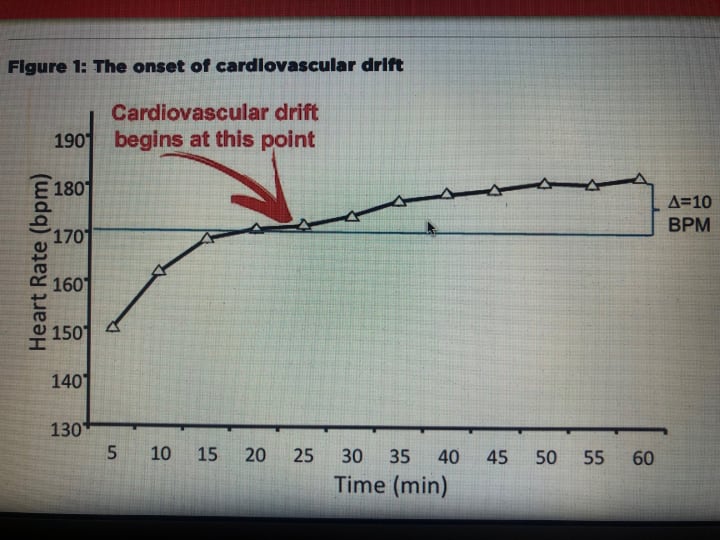What is Cardiac Drift?
A comparison and breakdown

Have you ever imagined drifting along in a canoe, all on your own, out in the open water... and then you get rocked?
Well, if you have... that's probably just swell, but it's not Cardiac Drift...
Perhaps, however, when you hear 'Cardiac Drift,' you visualize a car drifting around a corner… sort of like this, below.

Unfortunately, that's not it either.
'Car' Drifting, just happens to be something else entirely. The word, ‘cardiac,’ however, is referring directly to the heart.
So, as the saying goes: close but no cigar? 'Smokey Drift' (from the photo above) might very much agree here.

Anyway, I thought I would draw out a comparison for you, whilst explaining an interesting phenomenon.
Yet, we can use the car from above to further explain the fundamentals of how the engine (and likewise the heart) actually function. For, there are interesting similarities between the two; and, only with a clearer understanding of how the heart functions can we go on to understand the phenomenon of Cardiac Drift. So, therefore, let's break down some of the fundamentals.
As an example, suppose that a 4-cylinder engine is arranged like a boxer engine, with the pistons laying flat.

Now, suppose we go even further down the rabbit hole...
Imagine that we superimpose these cylinders so that they overlap with the 4 chambers of the human heart (not concerning ourselves with any finer details at the moment). We should, at once, see some striking similarities.
You can observe, that in the diagram of the Impreza (above), the engine cylinders happen to show valves, just the same as the chambers of the heart each have valves. But, where the valves of a car open to permit airflow into the cylinder once every 4 strokes (and, likewise, open to expel exhaust), the valves of the heart are otherwise entirely concerned with regulating blood (whether this be oxygenated or unoxygenated blood).
So, before we go much further than that, let's not lose sight of the original question: what is Cardiac Drift?
For starters, Cardiac Drift doesn't occur when one is at rest, but rather, whilst one is engaging in exercise.

The simplest explanation of Cardiac Drift would be the upward climb in Heart Rate over a given period of time.

And, this increase in Heart Rate (whilst engaging in exercise), does not coincide with a change in workload, pace, or intensity.
So, perhaps Cardiac Drift would be a little like having the engine of the Impreza cruise along the freeway, whilst the revolutions by the pistons in the cylinders (measured by the RPM gauge) start increasing, every minute, even though the car is not altering grade or slope... maybe?
Of course, a car doesn't typically start revving into the higher ranges whilst cruising in the same gear. Moreover, by design the cylinders are constant and unchanging, producing the same amount of Horse Power over Time. But, consider a diagram of the human heart (see below).

Cardiac Output is somewhat akin to Horse Power. There are many factors that can affect total Cardiac Output, much in the same way that Horsepower can be regulated. However, there is a general formula for both. In the case of Cardiac Output, we have the following: CO = HR x SV, where Heart Rate and Stroke Volume regulate the Cardiac Output. A strong heart, therefore, has a measurably low HR and a large SV at rest.
Stroke Volume (SV) is simply the volume of blood (in ml) that is pumped with ventricular contraction of the heart. And,
Heart Rate (HR) is measured in beats per minute. And,
Cardiac Output (CO) is the product of SV and Heart Rate and is measured in Litres per minute.
Yet, the jury is still out as to which mechanism(s) are specifically responsible for the phenomenon of Cardiac Drift; but one can speculate when examining the circulatory system as a whole. In fact, it may very well be, that a combination of factors are contributing.
Though it has been suggested, that the decrease in SV is the result of a number of factors affecting venous return (as per the Frank-Starling mechanism) not least of which is the fluid loss due to perspiration. Indeed, this conclusion would make the most sense.
Typically, the greater the SV the more blood is pumped with every Heart Beat. Therefore, as the SV and HR rise with the onset of exertion, the CO increases respectively. That being said, in such an event where blood is redirected to the periphery for heat dissipation, Venus Return (VR) would naturally fall and directly lower the available blood for the next ventricular contraction. Less blood available in the Right Chamber of the heart would result in a lower SV, respectively.
Whether or not this mechanism, is, in fact, responsible for Cardiac Drift, is still open to contention. Other postulations, of course, have been put forward. Such as the decrease in oxygen saturation and low glucose reserves, which both influence the available ATP required for muscle contraction.
What eventually happens though, is that HR compensates for the decrease in SV brought about by an inadequate VR to maintain the same CO. This continues until the maximum Heart Rate (MHR) is reached (or approached). Depending on your age and level of fitness the MHR can be calculated using the following formula: MHR = 220 - age, where 220 is a constant that denotes an upper ceiling. Anything above your MHR puts your heart in danger, just as the RPM gauge is marked red, up to 6000 rpm for gasoline engines.
Subsequently, approaching the MHR for your age during a bout of exercise quickly leads to exhaustion, and cessation of activity follows.
If you've read something here that is misguided, I'd love your feedback in the 'comment' section below, so that I can address the issue.
And, there's always a possibility (if your interest level is high), that you may wish to fund my research. If that is the case, please tip. :)
About the Creator
Delusions of Grandeur
Influencing a small group of bright minds with my kind of propaganda.






Comments
There are no comments for this story
Be the first to respond and start the conversation.